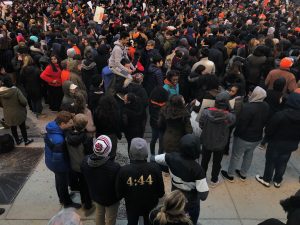Story by Michael Acker
Sept. 25, 2008 – It could be a whole new ball game for city youth if the Chicago City Council bans the use of metal baseball bats.
The City Council introduced an ordinance earlier this month that would prohibit organized baseball leagues in the city and the school district from using non-wooden bats.
Alderman Robert Fioretti (2nd) described this as a preventative measure to avoid injuries that have occurred to children throughout the country.
Christina Russo, of Barrington, voiced support for the ban at a press conference before the last full council meeting. She said her son, Tony, now 15, was struck by a baseball hit with a non-wooden bat on April 21, 2007, resulting in a fractured orbital lobe, a broken nose and torn sinuses.
“I do not want to see something like this happen to another child,” Russo said.
Tony has undergone plastic surgery due to the injury, Russo said. She also said that wooden bats would reduce the risk of such injuries, since they are not engineered to result in faster hits.
The proposed ban faces firm opposition from at least one major sporting goods manufacturer.
Jim Darby, vice-president of corporate affairs at Easton Sports, said that the sporting goods manufacturer is a member of the Don’t Take My Bat Away Coalition. The coalition is a network of parents, coaches and various governing bodies of baseball that oppose efforts to ban the use of aluminum and composite bats in amateur leagues.
“Our whole feeling on this is that people should have a choice,” Darby said.
Darby disagrees with claims that a baseball player can hit a baseball with a metal bat about 30 mph faster than with a wooden bat.
While Darby did not disclose sales figures comparing the sale of metal to wooden bats, he said that they do not sell as many wooden bats as they sell metal bats.
“We sell more no-wood bats than wood bats,” Darby said. “It’s an integral part of our business.”
Preston Maki, sales lead at the Sports Authority store on Clark Street in Chicago, said metal bats now have greater flexibility, resulting in hits that give infielders less time to react. While metal bats are generally more expensive than wooden bats, they are more durable and therefore do not need to be replaced as often, he said.
Maki said that the store does not sell high-end wooden bats that professional ballplayers use, since the maple or ash material breaks and has struck players and spectators. The basic wooden bat is safest for players and fans, he said.
James S. Oddo, a New York City councilman agrees that the wooden bat is safer for children to use than metal bats, and he supports Chicago’s effort to prohibit the use of the metal bat. He added that the New York City Council approved its ban despite several obstacles.
“No child in Chicago should be killed just to give Easton a profit,” Oddo said.
Darby cited a study commissioned by the Illinois High School Association that concluded ballplayers are not at greater risk of injury if they use alloy bats instead of wooden bats. He also said that insurance companies would not cover leagues if the metal bat were a safety concern.
Darby said that government intervention in this matter is not necessary, since there is no empirical evidence to support the argument that metal bats are more dangerous than wooden bats. He noted that manufacturers like Easton make bats that adhere to regulations that are set by various leagues, such as the NCAA, the Illinois High School Association and Little League Baseball, Inc.
“If there was a safety issue, they are the first to contact,” Darby said. “We make bats to the rules we are given.”
Nick Orlchula and Elisa Tavares Bell contributed to this report.
Categories:
At Play Editor’s Choice Local Politics Public Sports
Tags:
baseball chicago city council sports






Be First to Comment